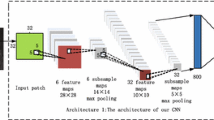Abstract
No-reference image quality assessment is of great importance to numerous image processing applications, and various methods have been widely studied with promising results. These methods exploit handcrafted features in the transformation or space domain that are discriminated for image degradations. However, abundant a priori knowledge is required to extract these handcrafted features. The convolutional neural network (CNN) is recently introduced into the no-reference image quality assessment, which integrates feature learning and regression into one optimization process. Therefore, the network structure generates an effective model for estimating image quality. However, the image quality score obtained by the CNN is based on the mean of all of the image patch scores without considering the human visual system, such as edges and contour of images. In this paper, we combine the CNN and the Prewitt magnitude of segmented images and obtain the image quality score using the mean of all the products of the image patch scores and weights based on the result of segmented images. Experimental results on various image distortion types demonstrate that the proposed algorithm achieves good performance.




Similar content being viewed by others
References
Thung, K.H., Paramesran, R.: A survey of image quality measures. In: Proceedings of international conference for technical postgraduates (TECHPOS). pp. 1–4 (2009)
Sheikh, H.R., Bovik, A.C., de Veciana, G.: An information fidelity criterion for image quality assessment using natural scene statistics. IEEE Trans. Image Process. 14(12), 2117–2128 (2005)
Zhang, L., Zhang, D., Mou, X., Zhang, D.: FSIM: a feature similarity index for image quality assessment. IEEE Trans. Image Process. 20(8), 2378–2386 (2011)
Li, Qiang, Wang, Zhou: Reduced-reference image quality assessment using divisive normalization-based image representation. IEEE Signal Process. Soc. 2(3), 202–211 (2009)
Narwaria, M., Lin, W., McLoughlin, I., Emmanuel, S., Chia, L.T.: Fourier transform based scalable image quality measure. IEEE Trans. Image Process. 21(8), 3364–3377 (2012)
Moorthy, A.K., Bovik, A.C.: A two-step framework for constructing blind image quality indices. IEEE Signal Process. Lett. 17(5), 513–516 (2010)
Moorthy, A.K., Bovik, A.C.: Blind image quality assessment: from natural scene statistics to perceptual quality. IEEE Trans. Image Process. 20(12), 3350–3364 (2011)
Saad, M., Bovik, A.C., Charrier, C.: Blind image quality assessment: a natural scene statistics approach in the DCT domain. IEEE Trans. Image Process. 21(8), 3339–3352 (2012)
Ye, P., Kumar, J., Kang, L., Doermann, D.: Unsupervised feature learning framework for no-reference image quality assessment. In: IEEE Conference on Computer Vision and Pattern Recognition (CVPR), pp. 1098–1105 (2012)
Mittal, A., Moorthy, A., Bovik, A.: No-reference image quality assessment in the spatial domain. IEEE Trans. Image Process. 21(12), 4695–4708 (2012)
Kang, L., Ye, P.: Convolutional neutral networks for no-reference image quality assessment. In: IEEE Conference on Computer Vision and Pattern Recognition (CVPR) (2014)
Narwaria, M., Lin, W.: Objective image quality assessment based on support vector regression. IEEE Trans. Neural Netw. 21(3), 515–519 (2010)
Narwaria, M., Lin, W.: SVD-based quality metric for image and video using machine learning. IEEE Trans. Syst. Man Cybern. Part B 42(2), 347–364 (2012)
Narwaria, M., Lin, W.S., Enis Cetin, A.: Scalable image quality assessment with 2D mel-cepstrum and machine learning approach. Pattern Recognit. 45, 299–313 (2012)
Chen, G.-H., Yang, C.-L., Xie, S.-L.: Gradient-based structural similarity for image quality assessment, conference: image processing. IEEE International Conference-ICIP, pp. 2929–2932 (2006)
Deng, L., Hinton, G.E., Kingsbury, B.: New types of deep neural network learning for speech recognition and related applications: an overview. In: IEEE International Conference on Acoustic Speech and Signal Processing (ICASSP 2013) (2013)
Krizhevsky, A., Sutskever, I., Hinton, G.E.: Imagenet classification with deep convolutional neural networks. NIPS 1, 4 (2012)
Felzenszwalb, PedroF, Huttenlocher, DanielP: Efficient graph-based image segmentation. Int. J. Comput. Vis.—IJCV 59(2), 167–181 (2004)
Mittal, A., Moorthy, A., Bovik, A.: No-reference image quality assessment in the spatial domain. IEEE Trans. Image Process. 21(12), 4695–4708 (2012)
Sheikh, H.R., Wang, Z., Cormack, L., Bovik, A.C.: LIVE image quality assessment database release2. http://live.ece.utexas.edu/research/quality
Ponomarenko, N., Lukin, V., Zelensky, A., Egiazarian, K., Carli, M., Battisti, F.: TID2008: a dataset for evaluation of full-reference visual quality assessment metrics. Adv. Mod. Radio Electron. 10, 30–45 (2009)
Author information
Authors and Affiliations
Corresponding author
Rights and permissions
About this article
Cite this article
Li, J., Zou, L., Yan, J. et al. No-reference image quality assessment using Prewitt magnitude based on convolutional neural networks. SIViP 10, 609–616 (2016). https://doi.org/10.1007/s11760-015-0784-2
Received:
Revised:
Accepted:
Published:
Issue Date:
DOI: https://doi.org/10.1007/s11760-015-0784-2




